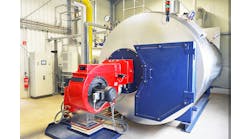This is a continuation of the October article regarding changes in hardwood flooring exposure temperatures.
Some wood flooring manufacturers are quite comfortable with the old standard of 85ºF maximum allowable floor surface temperatures, but to avoid conflicts, it is best to know what product will be in place over the radiant floor heating system, and what the wood floor manufacturers’ maximum recommended temperature of operation will be. If the calculated loads for the radiant floor exceed 20 Btu’s per square foot per hour (80ºF maximum exposure), then another means of load augmentation will be necessary to limit the floors operating temperature to 80ºF.
This augmentation can be radiant ceilings or walls, or convective methods of contribution. If augmentation is impossible to provide, then the consumer might want to look at some of the new “faux wood floor” tiles, made of ceramic and other well proven robust materials that do not have the same operating limitations. Having just recently installed this product on a project of my own, I can say that people really can’t tell that it is not a wood product, and it is extremely stable, highly conductive and beautiful in its presentation. I realize that the selection of the final finished product is not the responsibility of the radiant flooring contractor, but this is a good tool to have in your back product if the load exceeds 20 Btu’s per square foot per hour, and augmentation is not readily available.
Controls: The new NWFA standard calls out the need for in-floor or under-floor data loggers, that, in the words of the standard, “are strongly recommended to be installed in each room with wood flooring to ensure the conditions do not exceed flooring tolerances. Placement of these sensors should be determined along with the radiant heating system installer in order to gain the most accurate floor temperature readings.”
Although it doesn’t state who will supply and maintain these data loggers, this responsibility should be determined early in the bidding process. Additionally, the standard calls out the need for, “ An Outdoor Reset Control with High/Low temperature settings, along with an in-floor sensor should be installed with the system to minimize the effects of rapid changes in temperature, and subsequent damage to the wood floor. These sensors and thermostats allow the heating process to be gradual and based on small incremental increases in relation to the exterior temperature. It is also recommended not to use “set back” or programmable thermostats which would vary room temperature more than +/- 3º F, potentially resulting in trauma to the wood floor.”
My only recommendation is that you tell the lady of the house early on to please limit the placement of throw rugs over the hardwood floors to 10% of the available floor space.
In my opinion, this control requirement and floor sensing element will be the responsibility of the radiant floor heating contractor, because it does affect the control of the system. Although most people don’t think about it, I believe that this is important in “occasional use” types of homes, that spend most of their times set at 50ºF. and are only turned up when the occupants will be spending time there. The acceleration of a radiant floor heating system coming out of a deep set back condition takes time, especially when the rate of acceleration is significantly affected by this limitation. Again, another option would be the use of ceramic look-alike wood flooring with no limitations in operating temperatures, other than the well-known limitation of 85ºF.
Other hidden issues: One area that was spoken to but not addressed in the standard is the fact that in certain areas, there will be a high density of tubing centers in the immediate vicinity of a distribution manifold. This is going to require the radiant floor contractor to pay special attention to the tubing’s route, manner, and method. In the case of a staple down installation, being poured in a light weight cementitious material over a cement floor, or a gypsum based product, if the tubing can’t be installed at the usual density (12” on center for example) then it will be necessary to insulate the tubes in areas of high density to avoid the (commonly accepted) higher than usual floor temperatures due to all of the tubing emanating from the manifold. This would require that 1/2” pipe insulation be split in half and placed over the tubing that has been fastened to the floor.
On framed floors, it could require that the tube leaders (inactive transport) be buried beneath the floor and be insulated to avoid areas of high tube density, and higher than normal floor temperatures. Once they are in the room being served by the tube circuit (active tubing), then they would pop back up on top of the floors to deliver the heat directly to the room being heated. This will add complexity, and cost to the installed costs of a typical hydronic radiant floor heating system, but it can be compensated for in the bidding process.
An additional recommendation of the NWFA was to limit the placement of rugs and or carpeting. In their standard, they state “The end-user should be made aware of proper usage of the entire radiant heating system by the radiant heating system specifier and the radiant heating system installer, as it directly relates to the floor covering installed over it.”
Unfortunately, this is a battle that has been played out thousands of times. If the placement of throw rugs were incorporated into the architectural drawings, it wouldn’t be a problem. But they never show these details, and the woman of the house usually has a tractor trailer rig full of woven Indian rugs that she intends to place on the floor. I used to think that these ladies did this to avoid cold floors, which didn’t make sense to me, but was told by an interior decorator that it is done for acoustical purposes, to avoid echoes within the home. My only recommendation is that you tell the lady of the house early on to please limit the placement of throw rugs over the hardwood floors to 10% of the available floor space to avoid possible issues associated with hardwood flooring failures.
I’d like to acknowledge the input of the members of the RPA that contributed to this standard development process. I appreciate the many hours and wealth of technical experience that you and your organization contributed to this process. Although many of you were not happy with the final floor temperature limiting results, we must bear in mind that it is the manufacturers of the wood flooring systems that are making these limitations known and are responsible for the warranty surrounding these products, and not the RPA who is bringing them to light. If you can get information from the solid wood manufacturer of your choice allowing it to be exposed to 85ºF temperatures, then it’s a non-issue. Ours is not to wonder why, our is to comply or don’t fly.
Tune in next month as we continue our look at major changes for hardwood flooring applications.
Mark Eatherton material, in print and online, is protected by Copyright 2017. Any reuse of this material (print or electronic) must first have the express written permission of Mark Eatherton and CONTRACTOR magazine. Please contact via email at [email protected].


